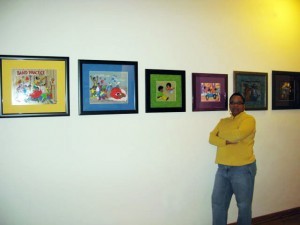The Museum Of UnCut Funk spoke with Tammy LaGorce, a writer for the New York Times, about Black people on money and other funky thangs!
We spoke with Tammy previously for an article she wrote on us for The Guardian.com, which you can read by clicking here.
Did I mention that this is the SECOND TIME WE HAVE BEEN COVERED ON THE FRONT PAGE IN THE NEW YORK TIMES!!!
You can read the entire article online at the New York Times website by clicking here.
This article ran on the front page of the Metro section of the New York Times on August 13, 2017.
The online version of the article was posted on the New York Times website on August 9, 2017.
You can read the entire article first article in the New York Times by clicking here.
This article ran on the front page of the Arts section of the New York Times on March 20, 2014.
The online version of the article was posted on the New York Times website on March 19, 2014.
The Money Museum Gets Funky
By Tammy LaGorge
August 9, 2017
Loreen Williamson and Pamela Thomas know that there are funkier figures in history than Booker T. Washington. Bear with them, though, and they will connect the dots that landed him in the Museum of UnCut Funk.
The visage of Mr. Washington, the 19th-century author and educator, is printed on a 1947 half-dollar coin featured in “For the Love of Money,” an exhibition of blacks on United States currency at the Museum of American Finance in Manhattan, on view through January. The show, with more than 35 coins, tokens, medallions and medals that celebrate black history leaders, events and institutions, is on loan from the Museum of UnCut Funk, the online destination for all things funky, which Ms. Williamson and Ms. Thomas began to curate about a decade ago.
“I bet you didn’t know there was all this money with actual black people on it,” Ms. Thomas said. “And I doubt anybody knows the process that was undertaken to get these people put on currency.” That process includes presidential authorization only after two-thirds of both the House and the Senate have first voted to approve the idea, she explained. “If you look at it from the perspective of, ‘Well, damn, I had no idea about this,’” she said, “that makes it pretty funky.”
Ms. Williamson continued, “This may be our most traditional show in that it’s the kind of thing you’d expect to see in a black history exhibition.” She and Ms. Thomas founded the funk museum, which usually focuses more on pop culture, in 2007. Besides Mr. Washington, other figures whose images are cast in bronze, gold and silver within the single-room show on Wall Street in the financial district include Joe Louis, Bessie Coleman and the Tuskegee Airmen.
A few of the objects, like a 2016 Harpers Ferry National Historical Park quarter, representing Washington, D.C., and another from Washington, featuring the Frederick Douglass National Historic Site, issued in 2017, are currently in circulation. But most, like two for President Barack Obama from his first and second terms in office, and Rosa Parks’s 1999 bronze medal, were pressed strictly to honor the subject, not to be used as money. Still, they represent what Ms. Williamson called a funky twist in how people think about the United States Mint.
Ms. Thomas and Ms. Williamson opened their online museum, which has all the usual elements of the brick-and-mortar kind, including a gift shop with T-shirts and coffee mugs, as a way of celebrating their blackness and their mutual love of 1970s black culture. “Fat Albert and the Cosby Kids” cartoon cels and blaxploitation movie posters can be viewed at the museum site. So can recorded interviews with James Brown, Isaac Hayes and Teddy Pendergrass, and the work of the pioneering black cartoonist Morrie Turner, whose comics appeared in publications like Negro Digest and Ebony.
A comprehensive “’Fro Back” exhibition offers a tour of the hairstyle. “’Fro Back,” like each of the museum’s 20 online exhibitions — “Black Barbie” is another — has titles and text panels. It includes a vintage Afro Sheen commercial and a slide show of Afros on household names like Malcolm X and Michael Jackson.
You can read the rest of the article online at the New York Times website by clicking here.
A version of this article appears in print on August 13, 2017, on Page MB1 of the New York edition with the headline: A Museum Finds All Kinds of Funk.



